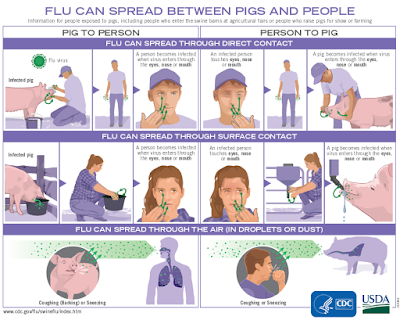#13,463
For the third week in a row the CDC's FluView is reporting 4 new swine variant H1N2v infections in humans, three of whom reported recent contact with swine.
A fourth case reported no swine contact, or attendance of a fair, suggesting - as we've seen before - that limited human-to-human transmission may have occurred. The CDC, however, reports no sign of ongoing, or sustained, transmission.While relatively rare, previous studies have suggested that the number of people who are infected each year with with swine variant influenza viruses far exceed the number are tested and confirmed infected (see CID Journal: Estimates Of Human Infection From H3N2v (Jul 2011-Apr 2012).
California, which until this summer had never reported a swine variant case, now leads this year's tally with 6 cases, followed by 3 each from Michigan and Ohio, and 1 from Indiana.Somewhat unusually, 12 of the 13 cases reported this year have been H1N2v, which has - until this summer - been the least commonly reported swine variant infection reported since 2005.
This from today's FluView report:
Novel Influenza A Virus:
An additional four human infections with novel influenza A viruses were reported by two states (California [2] and Ohio [2]). All four persons were infected with influenza A(H1N2) variant (A(H1N2)v) viruses and became ill with respiratory symptoms in early August 2018.
These patients were children < 18 years of age, were not hospitalized, and all are recovering or have fully recovered from their illness. Three patients reported exposure to swine at an agricultural fair during the week preceding illness onset. One patient reported no contact with swine and no attendance at an agricultural fair in the week preceding illness.
It is possible that limited human-to-human transmission occurred. No ongoing human-to-human transmission has been identified.
A total of 13 variant virus infections have been reported to CDC during 2018. One of these was with an influenza A(H3N2) variant (A(H3N2)v) virus (Indiana [1]), and 12 have been with A(H1N2)v viruses (California [6], Michigan [3], and Ohio [3]).
Early identification and investigation of human infections with novel influenza A viruses are critical so that the risk of infection can be more fully understood and appropriate public health measures can be taken. Additional information on influenza in swine, variant influenza infection in humans, and strategies to interact safely with swine can be found at http://www.cdc.gov/flu/swineflu/index.htm.
Additional information regarding human infections with novel influenza A viruses can be found at http://gis.cdc.gov/grasp/fluview/Novel_Influenza.html
Several weeks ago the CDC released a new infographic on preventing the spread of these viruses.
 | |||||
| https://www.cdc.gov/flu/pdf/swineflu/transmission-between-pigs-people.pdf |
The CDC's recommendations for people at a higher risk of influenza complications is to avoid pigs and swine barns altogether.
If you are at high risk of serious flu complications and are going to a fair where pigs will be present, avoid pigs and swine barns at the fair. This includes children younger than 5 years, people 65 years and older, pregnant women, and people with certain long-term health conditions (like asthma, diabetes, heart disease, weakened immune systems, and neurological or neurodevelopmental conditions).Two weeks ago, the CDC - in conjunction with the USDA and 4H - released an ambitious 60-page graphic novel on swine variant flu and how disease detectives investigate outbreaks.
The Junior Disease Detectives: Operation Outbreak Graphic Novel
Download the Graphic Novel Today
Web Version[21 MB, 60 Pages, Print Only]For more on the growing variety of influenza viruses circulating in North American swine, you may wish to revisit:
Home Print Version[166 MB, 60 Pages, Print Only]
Professional Print Version[159 MB, 60 Pages, Print Only]
Transbound Emerg Dis: H5N2, H1N2 & Other Reassortants In Mexican Swine
J. Virology: Pathogenesis & Transmission of H3N2v Viruses Isolated in the United States, 2011-2016
Virology: Detection & Characterization Of Avian H4N6 In Midwestern Swine (2015)
